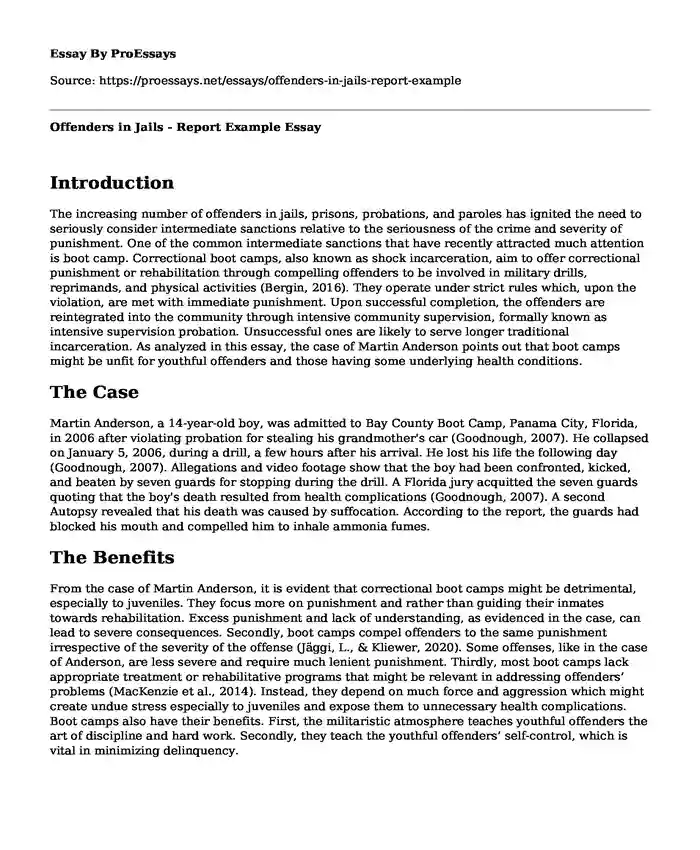Introduction
The increasing number of offenders in jails, prisons, probations, and paroles has ignited the need to seriously consider intermediate sanctions relative to the seriousness of the crime and severity of punishment. One of the common intermediate sanctions that have recently attracted much attention is boot camp. Correctional boot camps, also known as shock incarceration, aim to offer correctional punishment or rehabilitation through compelling offenders to be involved in military drills, reprimands, and physical activities (Bergin, 2016). They operate under strict rules which, upon the violation, are met with immediate punishment. Upon successful completion, the offenders are reintegrated into the community through intensive community supervision, formally known as intensive supervision probation. Unsuccessful ones are likely to serve longer traditional incarceration. As analyzed in this essay, the case of Martin Anderson points out that boot camps might be unfit for youthful offenders and those having some underlying health conditions.
The Case
Martin Anderson, a 14-year-old boy, was admitted to Bay County Boot Camp, Panama City, Florida, in 2006 after violating probation for stealing his grandmother's car (Goodnough, 2007). He collapsed on January 5, 2006, during a drill, a few hours after his arrival. He lost his life the following day (Goodnough, 2007). Allegations and video footage show that the boy had been confronted, kicked, and beaten by seven guards for stopping during the drill. A Florida jury acquitted the seven guards quoting that the boy's death resulted from health complications (Goodnough, 2007). A second Autopsy revealed that his death was caused by suffocation. According to the report, the guards had blocked his mouth and compelled him to inhale ammonia fumes.
The Benefits
From the case of Martin Anderson, it is evident that correctional boot camps might be detrimental, especially to juveniles. They focus more on punishment and rather than guiding their inmates towards rehabilitation. Excess punishment and lack of understanding, as evidenced in the case, can lead to severe consequences. Secondly, boot camps compel offenders to the same punishment irrespective of the severity of the offense (Jäggi, L., & Kliewer, 2020). Some offenses, like in the case of Anderson, are less severe and require much lenient punishment. Thirdly, most boot camps lack appropriate treatment or rehabilitative programs that might be relevant in addressing offenders’ problems (MacKenzie et al., 2014). Instead, they depend on much force and aggression which might create undue stress especially to juveniles and expose them to unnecessary health complications. Boot camps also have their benefits. First, the militaristic atmosphere teaches youthful offenders the art of discipline and hard work. Secondly, they teach the youthful offenders’ self-control, which is vital in minimizing delinquency.
The Future
Although the traditional boot camps concentrated on instilling discipline through basic military approaches, currently, they have begun emphasizing education and treatment. For instance, an increasing number of recruits to boot camps are convicts of drug abuse who require substance-abuse therapy. Besides, the concept of community correction is fast-developing. This is to suggest that juvenile boot camps will increase in the future. The courts, especially drug courts though the community corrections Acts, will liaise with boot camps and other community correction centers to foster rehabilitation through community service (MacKenzie et al., 2014). In the future, instead of taking a military approach, boot camps will spend more time in rehabilitative programs that focus more on intensive supervision probation. Given the advancement in technology, the camps might adopt remote-location monitoring and day reporting centers to enhance supervision.
Conclusion
The case of Martin Anderson paints the picture of boot camps as excessively aggressive and violent places where relevant officers are inconsiderate of the offenders' needs. It also indicates that the court takes less interest in offering justice to offenders in the camps. However, the literature indicates that the camps stand a greater chance of improving and attaining the intended goals.
References
Bergin, T. (2016). The evidence enigma: Correctional boot camps and other failures in evidence-based policymaking. Routledge.
Goodnough, A. (2007, October 13). 8 acquitted in death of boy, 14, in Florida. The New York Times - Breaking News, World News & Multimedia.
https://www.nytimes.com/2007/10/13/us/13bootcamp.html
Jäggi, L., & Kliewer, W. (2020). Reentry of incarcerated juveniles: Correctional education as a turning point across juvenile and adult facilities. Criminal Justice and Behavior, 009385482093413.
https://doi.org/10.1177/0093854820934139
MacKenzie, D. L., Gould, L. A., Riechers, L. M., & Shaw, J. W. (2014). Shock incarceration: Rehabilitation or retribution? Correctional Boot Camps: Military Basic Training or a Model for Corrections? 49-57.
https://doi.org/10.4135/9781483328874.n5.
Cite this page
Offenders in Jails - Report Example. (2024, Jan 01). Retrieved from https://proessays.net/essays/offenders-in-jails-report-example
If you are the original author of this essay and no longer wish to have it published on the ProEssays website, please click below to request its removal:
- International Cyber Crime(S) That Happen Related To Information Security on Web Servers
- Battered Women Syndrome as a Criminal Defense - Research Paper
- Significant Problems That Transgender Face in the Criminal Justice System
- Term Paper on Criminal Justice System: Challenges Facing the US
- Essay Example on Carrying Concealed Weapons: Majority of US States Allow It
- Ex-Convicts Reentering Society: Challenges & Solutions - Essay Sample
- Alcohol, Website Usability, Marijuana, and 'The Bourne Identity' - Free Report Example







